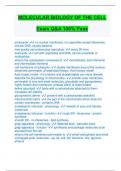MOLECULAR BIOLOGY OF THE CELL
Exam Q&A 100% Pass
prokaryote -✔✔ no nuclear membrane, no organelles except ribosomes,
circular DNA, usually bacteria
how quickly can prokaryotes reproduce -✔✔ every 20 mins
eukaryote -✔✔ cell with organelles and DNA, can be unicellular or
multicellular
what is the cytoskeleton composed of -✔✔ microtubules, actin filaments
and intermediate filaments
cell membrane of eukaryote -✔✔ double membrane around the nucleus,
selectively permeable, phospholipid bilayer, fluid mosaic model
fluid mosaic model -✔✔ proteins and phospholipids can move laterally
describe the physiology of mitochondria -✔✔ smooth outer membrane,
permeable to ions and small molecules, glycolipids and glycoproteins,
highly folded inner membrane (cristae) which is impermeable
define glycolipid -✔✔ lipids with a carbohydrate attatched to them -
increases cell stability
glycoproteins define -✔✔ proteins with a carbohydrate attached
mitochondrial matrix -✔✔ the part of the mitochondria which does not
contain membranes - contains DNA
endoplasmic reticulum - physiology -✔✔ network of sacs and tubules
(cisternae)
endoplasmic reticulum - function -✔✔ rough ER - ribosomes - protein
synthesis
smooth ER - no ribosomes - lipid synthesis
golgi apparatus - physiology -✔✔ flattened sacs - pancake stack
golgi apparatus - function -✔✔ synthesise and package molecules to be
secreted from the cell
what is the cell membrane permeable to -✔✔ small hydrophobic and small
uncharged polar molecules - eg. o2, co2, N2, benzene, h2o, glycerol,
ethanol
,what is the cell membrane impermeable to -✔✔ large uncharged polar
molecules - eg. amino acids, glucose, nucleotides, h+, NA+, HCO3-, K+,
Cl-
ribosomes function -✔✔ site of protein synthesis
how was mitochondria formed -✔✔ endosymbiosis -An ancestral eukaryotic
cell ingested, but did not digest an aerobic bacterium, which over time
evolved into a mitochondrion.
how did chloroplasts form? -✔✔ endosymbiosis - An ancestral eukaryote
ingested, but did not digest a photosynthetic bacterium, which over time
evolved into a chloroplast
chloroplast physiology -✔✔ double membrane
outer membrane is permeable to ions and small molecules
inner membrane is impermeable
thylakoids
lumen
stroma
define thylakoid -✔✔ inside a chloroplast, formed by folded membranes,
they're folded into stacks called grana (grana have light harvesting
pigments and synthesise ATP)
define lumen in chloroplasts -✔✔ space between thylakoids
Stroma -✔✔ colourless fluid surrounding the thylakoids and grana inside
the inner membrane
golgi apparatus distinct orientation -✔✔ cis face - adjacent to ER
trans face - point towards plasma membrane
vacuoles function -✔✔ site of degradation in plants, they also act as
storage organs, detoxification sites
define peroxisomes -✔✔ small microbody - site of detoxification in both
humans and plants
exocytic (exocytosis) pathway -✔✔ movement of substances from inside
the cell to the outside
1. proteins synthesised in ER sent to golgi
2. golgi packages proteins in vesicles for transport
3.travel through golgi - continuing to glysate
4. reach the trans face of the golgi and are excreted to the cell membrane
define glycosylation -✔✔ joining sugar molecules to proteins
cytoskeleton define -✔✔ a network of protein filaments that extends
through the cytoplasm
, three parts of the cytoskeleton -✔✔ 1. actin filaments
2. intermediate filaments
3. microtubules
function of the cytoskeleton -✔✔ support, shape, motility, cell division
actin filaments - cytoskeleton - function -✔✔ cell shape, motility, muscle
contraction
actin filaments - structure -✔✔ subunits - globular actin
filaments - twisted into chains
intermediate filaments -✔✔ subunits - intermediate proteins
twisted together like rope
found in - cytoplasm of animals and nucleus
which of the three cytoskeleton components is the strongest -✔✔
intermediate filaments
cytoskelton - microtubules -✔✔ found in all eukaryotic cells
subunits - tubulin dimer a and b
dimers stack into filaments which forms the wall of the tubule
what is a tubulin dimer -✔✔ a microtubule sub unit
function and location of microtubules in cytoskeleton -✔✔ function -
intracellular organisation, mitosis
location - extend from spindles and centromeres
why do polar covalent bonds occur -✔✔ when you bind two electrons with a
difference in electronegativity you get a positive or negative charge
depending on how much they differ
hydrogen bonds -✔✔ 1/20th of the force you get from a covalent bond
hydrogen bound to N, O or F
examples of covalent bonding -✔✔ h2o`
macromolecules examples -✔✔ DNA, RNA, proteins, polysaccharides,
lipids, phospholipids
whats the most abundant compound in a cell besides water -✔✔
macromolecules
monosaccharides -✔✔ simple form of sugar, hydrate of carbon
eg. glucose and maltose
polysaccharides -✔✔ composed of sugar subunits or monosaccharides




